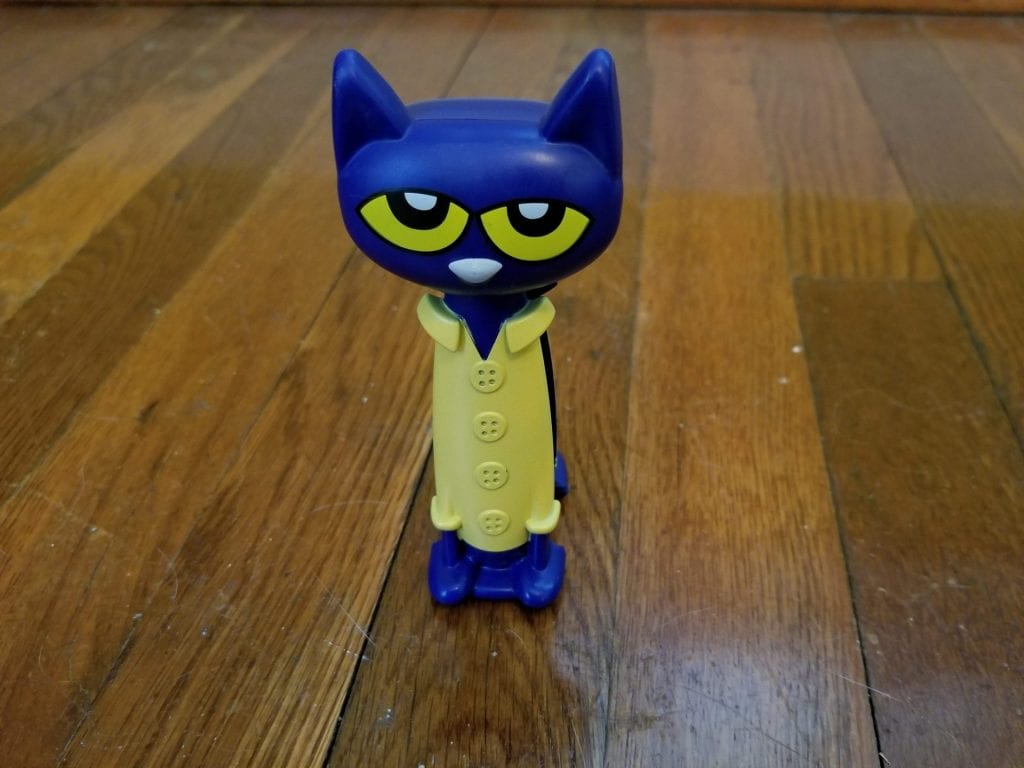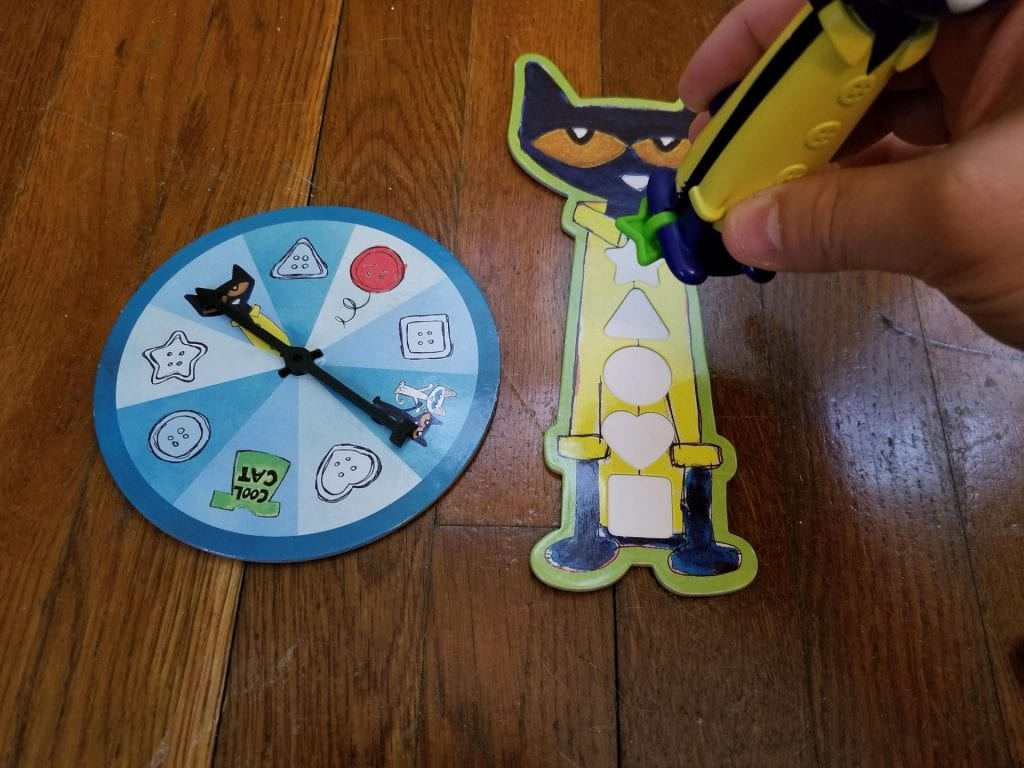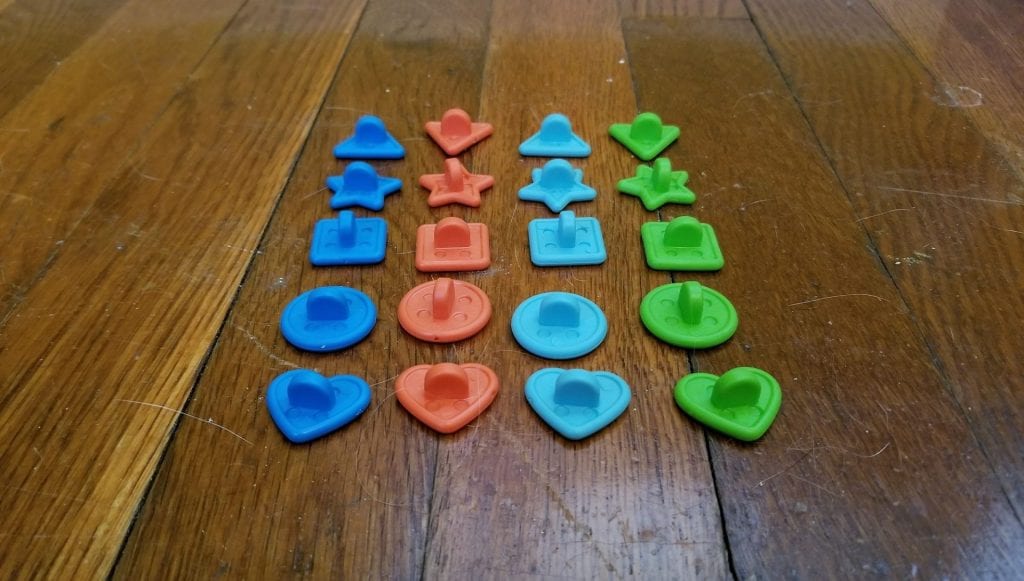Disclosure: Meeple Mountain received a free copy of this product in exchange for an honest, unbiased review. This review is not intended to be an endorsement.
Pete the Cat is a series of children’s books written by James Dean and illustrated by he and his wife (with the exception of the first 4 books in the series which were penned by Eric Litwin). In each book, Pete (the titular cat) is confronted with a lot of unfamiliar and uncomfortable situations. But whether it’s ruining his new shoes or going to a new school, Pete never lets life’s little irritations get him down. The books stress adaptability and positivity in the face of tribulation.
Overview
In Pete the Cat: I Love My Buttons Game (Pete the Cat from here on out), the players are competing to gather the various types of buttons from Pete’s bedroom floor and attach them to Pete’s coat. True to the tone of the books, though, the players will face a little opposition along the way. To quote the book this game was inspired by (Pete the Cat and His Four Groovy Buttons): “Buttons come and buttons go”. Buttons will be lost. Turns will be skipped. Players may even be forced to give some of their hard earned buttons to their neighbors. In the end, the first player to successfully complete their button collection will win the game.
Playing the Game
To begin the game each player is given a Pete board, while the buttons are scattered across the floor of Pete’s bedroom floor (the inside of the game box) with the little nubs facing upwards. These little nubs are used in conjunction with the Pete Squeezer (basically, a giant pair of tweezers shaped and colored like Pete the Cat) to lift the buttons free from the box and place them into their slots on the Pete boards. There is also a spinner included which will dictate the action a player performs on their turn, whether it be to collect a specific type of button or something else. The buttons come in 4 distinct shapes—circle, square, triangle, and heart—and 4 distinct colors—red, green, blue, and light blue. The colors are largely unimportant (aside from their educational usefulness), but the shapes definitely matter as you’ll soon see.

Pete the Cat does not include a suggestion for different game modes; opting to present the players with the rules of the game and nothing else. That being said, from a parental angle, I find it useful to observe and study the different components with my child taking time to identify the different shapes and colors, practicing flicking the spinner, and just appreciating the quality of the components for what they are rather than just as smaller parts of a larger whole.
Skills For Life: Appreciating and understanding each separate part of the larger whole will serve your child well one day when they’re playing A Fake Artist Goes to New York and find themselves on the receiving end of a “Fake” card. A Fake Artist Goes to New York has the players cooperatively creating a drawing of a word or a phrase, but the “Fake” has no idea what they’re drawing. They must use the work that’s already been done to guide their hand and hopefully fool the other players.
Pete the Cat is not a complicated game to play. The active player spins the dial. If the dial lands on a button type, the player collects the depicted button using the Pete Squeezer and places the button into its appropriate indentation on their Pete board. Additional actions include Pete deciding to wear his Cool Cat Boogie t-shirt (which returns all of the player’s collected buttons to the box), Pete wearing his coat (which lets the player take a button of their choice), Bye Bye Button! (which returns a button of the player’s choice back to the box), or Sharing Day! (which forces the player to pass a button of their choice to the player on the right).

After taking their turn, the active player passes the spinner and Pete Squeezer to the next player who then takes their turn. Play continues in this fashion until a player has filled in their Pete board. That player instantly wins.
Skills For Life: The goal of collecting all of the different types of buttons is an excellent introduction to the concept of set collection. Knowledge of this game mechanic will serve your child well one day when they’re sitting around and playing a game of Point Salad with their friends.
Thoughts
“I want to play the cat game, daddy.”
It’s become a mantra here in my household. Mere months away from turning 3, my son knows what he likes and what he likes, in particular, is Pete the Cat which is surprising since we do not own a single Pete the Cat book and, to my knowledge, he has never experienced Pete the Cat anywhere else. That alone should say something about the appeal of this game, at least where 2-3 year olds are concerned. While there are plenty of challenges for younger children to overcome (the dexterity required to flick the spinner, matching shapes with their receptacles, etc.), I doubt that children much older than that would find it challenging or as engaging. Because, let’s face it, it’s a very simple game.

Pete the Cat does come with a few unexpected challenges, though, and they’re not just challenges for the younger players to overcome. There are a few holes in the gameplay that the rules do not adequately prepare you to deal with. For instance, what happens if the spinner lands on a button type that you already possess? Do you spin again? The rules don’t say. Or what happens if you land on a Sharing Day and have nothing to share or the person to your right already has the same button type as the only button you have that you can share? The rules don’t say. These aren’t just small outlier issues, either. These situations arise in every single game. As a parent, I just make something up that favors my child’s progress in the game. But as a gamer, it annoys me that these issues weren’t better addressed in the rules.
These are minor quibbles, though. What irks me more than anything is the similarity between some of the button colors. Young children are just learning about colors and it’s a huge ask to make them distinguish between dark blue and light blue. I’m not sure why this decision was made, but I feel like using a color like purple would have been a better decision. I can understand why yellow is avoided since there is already a great deal of yellow in the game. This just feels like a missed educational opportunity.

Another small grievance is that this game is almost exactly the same as The Sneaky Snacky Squirrel that came out 3 years earlier. Spinner that determines which items you collect or actions you perform? Check. Cute little thingamabob to pick up the items? Check. Player board with recessed holes used to hold the items? Check. The only significant difference between the two (aside from how they look) is that Pete the Cat’s items are different shapes, so that presents a learning opportunity not present in The Sneaky Snacky Squirrel. In my mind, it’s like I’m playing the exact same game. In the mind of my son, though, the two are entirely different and he gets as much enjoyment from playing one as playing the other.
And, really, I suppose that’s all that matters. My kid loves playing this game and I love playing games with him. So for that reason alone, Pete the Cat gets my thumbs up.










